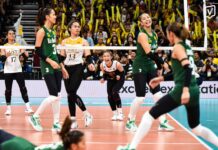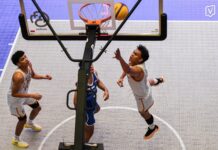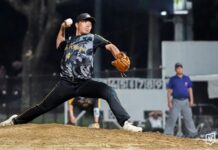A minute left in the game, two points behind, and our favorite Growling Tiger lies injured on the hard court—at the most crucial moment down the stretch. Benchmen rush out to aide him, while a hoarse coach calls for a timeout. The game hangs by a thread.
While all eyes are on the game, the Varsitarian takes the spotlight away from the jersey-clad players to the people in the mainstay.
Fellow Thomasians, meet the people behind the making of a Tiger.
Inside the den
Before the UST Tigers come out of their dens to face their adversaries, they undergo intensive tests from faculty members of the College of Rehabilitation Sciences (CRS) and researchers of the Center for Research on Movement Sciences (CRMS).
CRS Professors Janine Dizon and Tifanny Mallillin have been giving performance tests to the Tigers for the past two years and have recently worked with the Tigresses and the Tiger Cubs.
“During the pre-season, physiologic tests are given to the athletes to assess their level of endurance, body strength, speed, and agility,” Dizon said. “After the tests, a training program is designed to address the athletes’ weak points.”
The tests employed for the athletes include: medicine ball throw for upper extremity strength; vertical jump for lower extremity strength; 20-meter sprint for agility and speed; sit and reach for flexibility; and a multi-stage fitness test, the VO2 Max, for endurance and aerobic power.
A post-test before the UAAP opening is conducted to determine any improvement after the training period. In addition, physical therapists monitor the injuries of the players during the UAAP season.
“For every game, we provide sports emergency measures including first aid and therapy for players who get injured,” Dizon said. “At the end of the season, we compile the data and produce a profile of the players and the injuries they sustained during the season.”
CRMS head Joven Cerdenia highlights the importance of monitoring the fitness profile and injuries of athletes. “Once we know the fitness profile of an athlete, we can work on his weaknesses in order to prevent future injuries,” he said. Recommendations based on the test results are given to the coaching and the training staff who oversee the athletes’ training.
Working on the growl
For Thomasian athletes, the training never really ends. Even before the season starts, they pump iron at the CRMS gym near the Thomas Aquinas Research Complex.
Angelito Guilas, UST official athletics weights trainer, said that athletes go back to training almost as soon as the UAAP season formally ends.
“During the off-season, players undergo pre-conditioning for continuous training,” he said.
To reach their “peak performance” in the mid-season, the athletes are subjected to light weights and general exercises in the pre-season while slowly introduced to heavier exercises that target specific body parts as they approach the season proper.
According to Guilas, weight lifting should be done only from 30 minutes to one hour daily, depending on the program an athlete is in. There are different programs for the athletes, namely: strength-hypertrophy for body building, strength-endurance for improving muscle endurance, and plyometrics for enhancing power generation.
As of now, the CRMS weights room can only accommodate male, female, and junior basketball players, and male tennis players. Other varsity players work out outside UST.
A Tiger’s diet
Sports nutritionist Prof. Karen Pineda of the CRS said that proper food intake is vital for maximized performance.
Pineda talks to athletes about proper diet—food, fluid, and supplement intake—before, during, and after training sessions and official games.
“I compute the data and compare the results with the standard or recommended nutrition allowance,” she said.
Pineda explained that counseling sessions are conducted with athletes to provide them the necessary information to enhance diet. Tiger Cubs captain Marc Panahon and co-captain Oscar Crisostomo follow a strict diet and timetable for eating. Players must eat a full meal three to four hours before a game to give way to proper digestion.
Among the many supplementary drugs in the market, Thomasian experts like Guilas only recommend creatine for additional energy source during competitions. Tiger forward Francis Allera advises a carbohydrate and protein-rich diet for balanced nutrition.
Calling in Dr. Dolittle
A healthy body needs a healthy mind; UST athletes are also given the right formula for that.
“Athletes are still human. We need to address their mental and emotional sides,” the Tigress’ sports psychologist, Prof. Glody Reyes, said.
Part of the psychological support Reyes provides to UST Tigresses include individual and group counseling, and stress management. The job of a sports psychologist, she said, is to balance an athlete’s emotions and intellect.
According to Reyes, athletes tend to become lax and overconfident after winning, or depressed after losing a game. The psychologist helps the athletes deal with these extremes.
“During the pre-season, I meet with the athletes individually or in groups for several times a week,” explained Reyes. “As we go deeper into the season, the sessions become less intense since they need to focus more on the games.”
The science of the game
Two years ago, the University became the second college in the Philippines to introduce sports science as a course after the University of the Philippines. Since then, the course has emerged as the new trend in the sports development programs of the University.
According to sports science chair Prof. Josephine Reyes, the subject includes research and science-based study of biomechanics that covers the physiological aspect of the human body and the psychological aspect of proper exercising and training.
Reyes believes that sports science can improve the sports development program not only in the University but also in the country.
In its effort to stress the importance of sports science, the CRS held a nationwide convention last June titled “Science in Sports towards a Competitive Edge.” Guests from the Hong Kong Sports Institute discussed various applications of science in the field of sports.
According to CRS Dean Dr. Consuelo Suarez, not all Tigers get sports science support. Due to lack of manpower, only the athletics, basketball, and tennis teams receive backup. However, she is optimistic that all the teams will have science-based support in the future.
“If we want to excel in (the national) and international level, we have to stress the importance of science in sports,” said Suarez. “One way is to educate the coaches (about sports science).”
However, Tigers Coach Reonel Parado believes that basic skills are as important as any scientific undertaking.
“Even minimal flaws in the players’ basic skills eventually pile up and significantly affect the athlete’s performance,” Parado explained.
Under the leadership of Dr. Suarez, the entire support system of therapists, trainers, nutritionist, and psychologists have geared up the UST athletes for the coming UAAP season. However, the crux of the game still lies in the battle ahead. Reagan D. Tan, Deni Rose M. Afinidad, and Jefferson O. Evalarosa

















